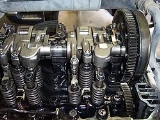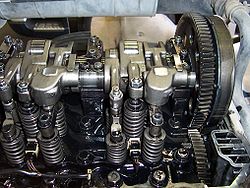
Jake brake
Encyclopedia

Engine braking
Engine braking is where the retarding forces within an engine are used to slow a vehicle down, as opposed to using an external braking mechanism, for example friction brakes or magnetic brakes....
mechanism installed on some diesel engine
Diesel engine
A diesel engine is an internal combustion engine that uses the heat of compression to initiate ignition to burn the fuel, which is injected into the combustion chamber...
s. When activated, it opens exhaust valves in the cylinders, releasing the compressed air trapped in the cylinders, and slowing the vehicle.
Although Jake brake properly refers to the Jacobs brand of engine brakes, the term has become a genericized trademark
Genericized trademark
A genericized trademark is a trademark or brand name that has become the colloquial or generic description for, or synonymous with, a general class of product or service, rather than as an indicator of source or affiliation as intended by the trademark's holder...
and is often used to refer to engine brakes or compression release engine brakes in general, especially on large vehicles or heavy equipment.
Function
When the driver releases the accelerator on a moving vehicle powered by a diesel engineDiesel engine
A diesel engine is an internal combustion engine that uses the heat of compression to initiate ignition to burn the fuel, which is injected into the combustion chamber...
, the vehicle's forward momentum
Momentum
In classical mechanics, linear momentum or translational momentum is the product of the mass and velocity of an object...
continues to turn the engine's crankshaft
Crankshaft
The crankshaft, sometimes casually abbreviated to crank, is the part of an engine which translates reciprocating linear piston motion into rotation...
, drawing air into the cylinders as the pistons move down and compressing that air as the pistons move back up. The pressure of the compressed air pushes back on the up-going piston, tending to slow the vehicle.
But, without a compression release mechanism, as the piston passes through top dead center
Dead centre
In a reciprocating engine, the dead centre is the position of a piston in which it is farthest from, or nearest to, the crankshaft. The former is known as top dead centre while the latter is known as bottom dead centre ....
and heads back down again, the compressed air in the cylinder acts as a spring and pushes the piston
Piston
A piston is a component of reciprocating engines, reciprocating pumps, gas compressors and pneumatic cylinders, among other similar mechanisms. It is the moving component that is contained by a cylinder and is made gas-tight by piston rings. In an engine, its purpose is to transfer force from...
down, returning most of the work done in compression back to the crankshaft, tending to accelerate the vehicle. The net effect is that the engine turns freely and the vehicle coasts.
When a compression release engine brake is active, a valve releases the pressure from the cylinder before the piston starts back down, so the slowing effect is present on the up stroke, but no accelerating effect is present on the down stroke and the net effect is the vehicle slows down.
With a gasoline engine, the mechanics are different and a special valve is not necessary for engine braking to happen when the driver releases the accelerator. In the gasoline engine, with the accelerator released, a throttle
Throttle
A throttle is the mechanism by which the flow of a fluid is managed by constriction or obstruction. An engine's power can be increased or decreased by the restriction of inlet gases , but usually decreased. The term throttle has come to refer, informally and incorrectly, to any mechanism by which...
prevents the free flow of air into the cylinders, so there is little pressure to release at the top of the compression stroke. The throttle itself provides engine braking through friction in the air flowing through it. But a diesel engine does not have a butterfly valve to limit air on the intake side.
A compression release engine brake uses an extra lobe on the camshaft
Camshaft
A camshaft is a shaft to which a cam is fastened or of which a cam forms an integral part.-History:An early cam was built into Hellenistic water-driven automata from the 3rd century BC. The camshaft was later described in Iraq by Al-Jazari in 1206. He employed it as part of his automata,...
to open a second exhaust valve at the top of the compression stroke. The stem of this valve telescopes during normal operation so the valve remains closed, but is locked at full length by a solenoid
Solenoid
A solenoid is a coil wound into a tightly packed helix. In physics, the term solenoid refers to a long, thin loop of wire, often wrapped around a metallic core, which produces a magnetic field when an electric current is passed through it. Solenoids are important because they can create...
when the engine brake is engaged so that the valve opens as directed by the cam. This releases the compressed air in the cylinder as described above.
The driver controls consist of an on/off switch and, sometimes, a multi-position switch that controls the number of cylinders on which the brake is active. When the driver has turned on the compression release engine brake, it will activate when the driver releases the accelerator. There are also switches on the clutch and accelerator pedals that deactivate the compression brake when the driver disengages the clutch or presses the accelerator.
The name is derived from the manufacturer, Jacobs (of drill chuck fame), and was patented 1962-'65 by Clessie Cummins.
Legislation
The use of compression release engine brakes may cause a vehicle to make a loud chattering or "machine gunMachine gun
A machine gun is a fully automatic mounted or portable firearm, usually designed to fire rounds in quick succession from an ammunition belt or large-capacity magazine, typically at a rate of several hundred rounds per minute....
" exhaust noise, especially vehicles having high flow mufflers, or no mufflers at all, causing many communities in the United States
United States
The United States of America is a federal constitutional republic comprising fifty states and a federal district...
to prohibit compression braking within municipal limits. Drivers are notified by roadside signs with legends such as "Brake Retarders Prohibited," "Engine Braking Restricted," "Jake Brakes Prohibited," "No Jake Brakes," "Compression Braking Prohibited," or "Unmuffled Compression Braking Prohibited," and enforcement is typically through traffic fines. Such prohibitions have led to the development of new types of muffler
Muffler
A muffler is a device for reducing the amount of noise emitted by the exhaust of an internal combustion engine. A US Patent for an Exhaust muffler for engines was granted to Milton and Marshall Reeves in 1897....
s and turbocharger
Turbocharger
A turbocharger, or turbo , from the Greek "τύρβη" is a centrifugal compressor powered by a turbine that is driven by an engine's exhaust gases. Its benefit lies with the compressor increasing the mass of air entering the engine , thereby resulting in greater performance...
s to better silence compression braking noise.
See also
- Engine brakingEngine brakingEngine braking is where the retarding forces within an engine are used to slow a vehicle down, as opposed to using an external braking mechanism, for example friction brakes or magnetic brakes....
- compression releaseCompression releaseA compression release mechanism works to ease the starting of internal combustion engines by allowing them to spin up to starting speed without having to work against the pumping action of the pistons...
- Exhaust brakeExhaust brakeAn exhaust brake is a means of slowing a diesel engine by closing off the exhaust path from the engine, causing the exhaust gases to be compressed in the exhaust manifold, and in the cylinder. Since the exhaust is being compressed, and there is no fuel being applied, the engine works backwards,...
- Retarder (mechanical engineering)Retarder (mechanical engineering)A retarder is a device used to augment or replace some of the functions of primary friction-based braking systems, usually on heavy vehicles....

